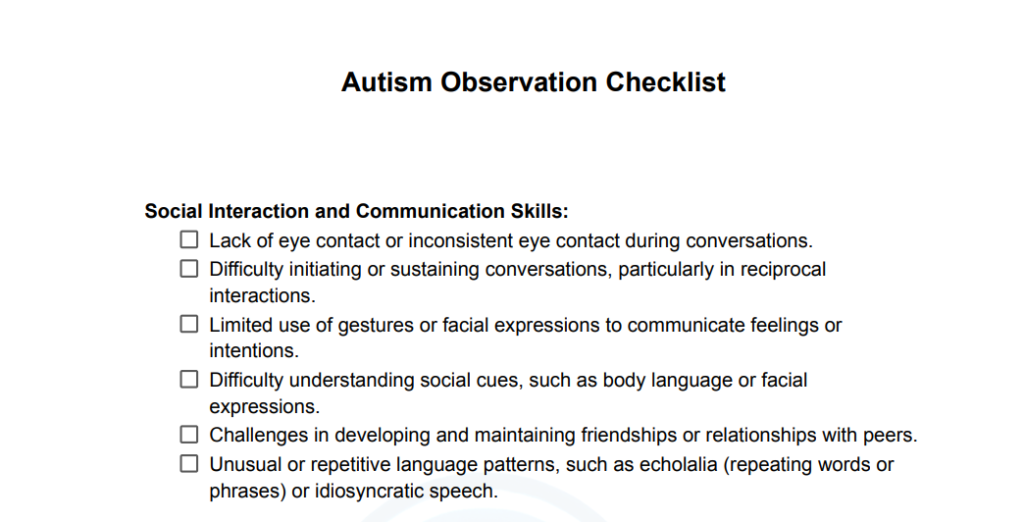Autism spectrum disorder (ASD) is a complex neurodevelopmental condition that affects individuals in various ways, impacting their social interactions, communication skills, behaviors, and sensory experiences. Early identification and intervention are crucial for individuals with ASD to receive appropriate support and services. One valuable tool in the assessment process is the Autism Observation Checklist, which helps professionals and caregivers systematically observe and document behaviors associated with autism. In this article, we’ll explore how to effectively use an Autism Observation Checklist to aid in the evaluation and understanding of individuals with ASD.

Download Your FREE Autism Observation Checklist PDF Now
Download your FREE PDF resource of Autism Observation Checklist.
1. Familiarize Yourself with the Checklist:
Before using the Autism Observation Checklist, it’s essential to thoroughly familiarize yourself with its components and categories. Different checklists may focus on various domains such as social communication, repetitive behaviors, sensory sensitivities, emotional regulation, and cognitive abilities. Understanding what each item on the checklist entails will ensure accurate observations and evaluations.
2. Create a Structured Observation Environment:
To effectively observe and assess an individual with ASD, it’s beneficial to create a structured and comfortable environment. Minimize distractions, provide familiar objects or activities, and ensure proper lighting and seating arrangements. This setting allows for focused observation without overwhelming the individual.
3. Observe and Document Behaviors:
During the observation process, pay close attention to the individual’s behaviors across different contexts. Use the checklist to systematically document observable behaviors related to social interactions, communication skills, sensory responses, repetitive behaviors, emotional regulation, and other relevant areas. Note the frequency, intensity, and duration of each behavior.
4. Use Multiple Sources of Information:
While direct observation is crucial, it’s also valuable to gather information from multiple sources. Collaborate with family members, teachers, therapists, and other professionals involved in the individual’s care. Incorporate information from developmental history, interviews, standardized assessments, and previous evaluations to gain a comprehensive understanding of the individual’s strengths and challenges.
5. Consider Developmental and Contextual Factors:
When using the Autism Observation Checklist, consider developmental factors such as age, cognitive abilities, language proficiency, and cultural background. Recognize that behaviors may vary in different contexts and settings. Take into account environmental factors, such as sensory stimuli, transitions, and social demands, that may influence the individual’s behavior and responses.
6. Identify Patterns and Trends:
As you observe and document behaviors over time, look for patterns, trends, and consistencies in the individual’s presentation. Identify strengths, areas of concern, triggers for challenging behaviors, and potential coping strategies or adaptations. Consider how these observations align with the diagnostic criteria for ASD outlined in diagnostic manuals such as the DSM-5 (Diagnostic and Statistical Manual of Mental Disorders, Fifth Edition).
7. Collaborate with Interdisciplinary Team Members:
Utilize the Autism Observation Checklist as a collaborative tool within an interdisciplinary team. Share your observations, findings, and interpretations with other professionals involved in the assessment and intervention process. Collaborative discussions and data sharing contribute to a holistic understanding of the individual’s needs and inform tailored interventions and support strategies.
8. Tailor Interventions and Support Strategies:
Based on the observations and insights gathered through the checklist, develop individualized interventions and support strategies. Focus on addressing specific areas of challenge while capitalizing on the individual’s strengths and interests. Incorporate evidence-based practices, therapeutic interventions, educational accommodations, and family-centered approaches to promote positive outcomes and enhance quality of life.
9. Monitor Progress and Adjust Strategies:
Continuously monitor the individual’s progress and response to interventions. Regularly review and update the Autism Observation Checklist to track changes in behaviors, skills, and functioning over time. Adjust intervention strategies as needed, seek input from the individual and their caregivers, and collaborate with the interdisciplinary team to optimize outcomes and promote lifelong success.
10. Empower and Educate Caregivers:
Finally, empower and educate caregivers, including parents, family members, teachers, and support providers, on how to use the Autism Observation Checklist effectively. Guide observation techniques, behavior management strategies, communication approaches, and resources for ongoing support and education. Encourage open communication, partnership, and a strengths-based approach to fostering the well-being and development of individuals with ASD.
In conclusion, the Autism Observation Checklist is a valuable tool for professionals and caregivers involved in the assessment, intervention, and support of individuals with ASD. By systematically observing, documenting, and analyzing behaviors across multiple domains, this checklist facilitates a comprehensive understanding of the individual’s unique profile and informs evidence-based interventions that promote positive outcomes and enhance quality of life.







